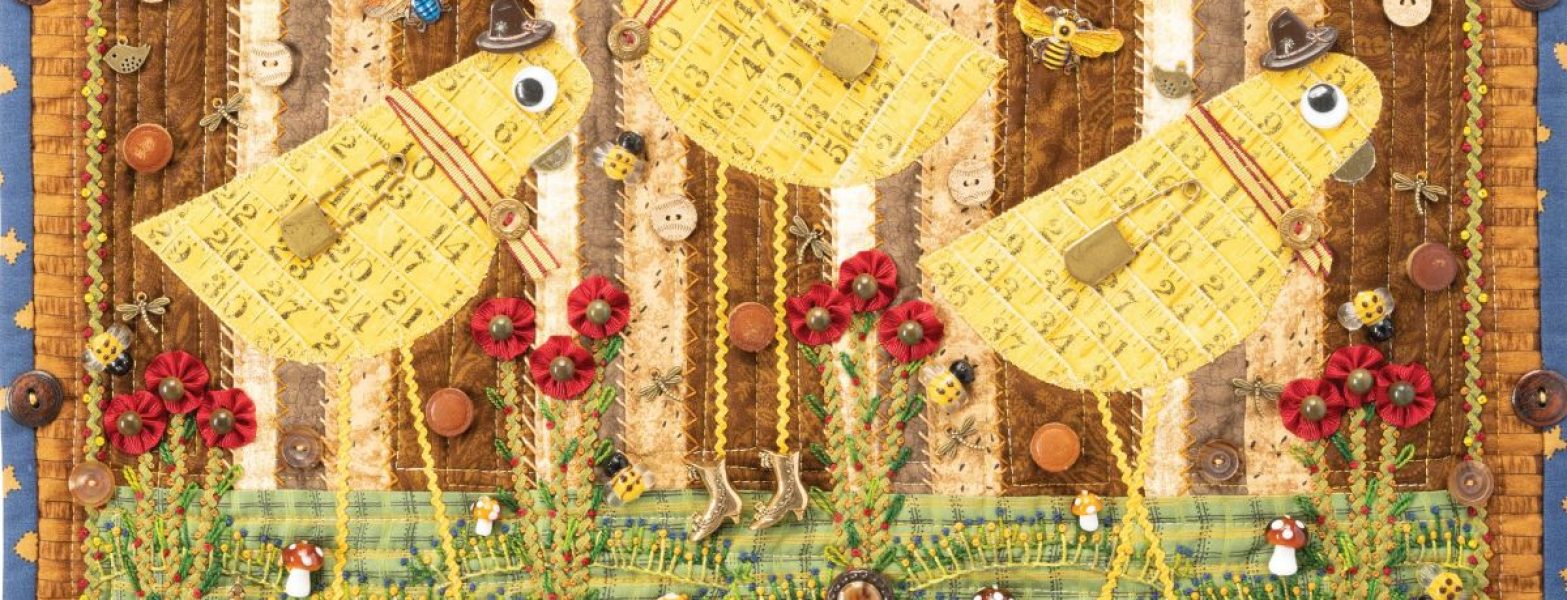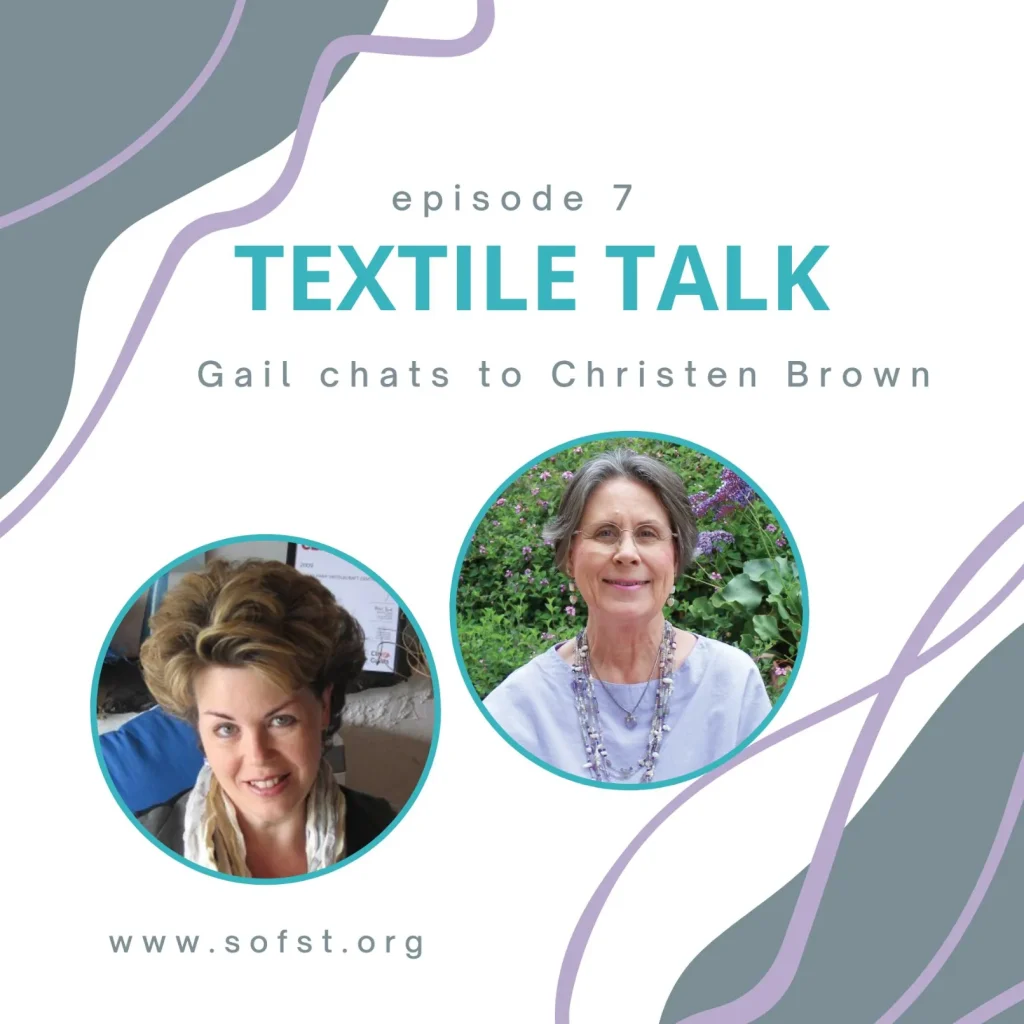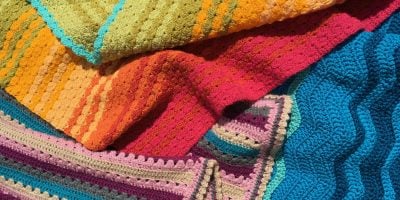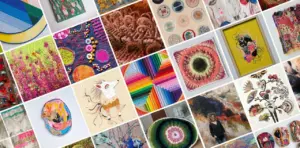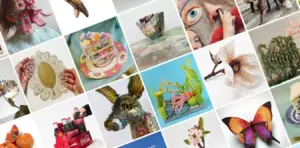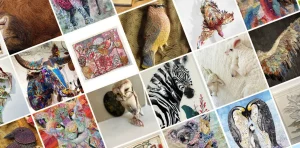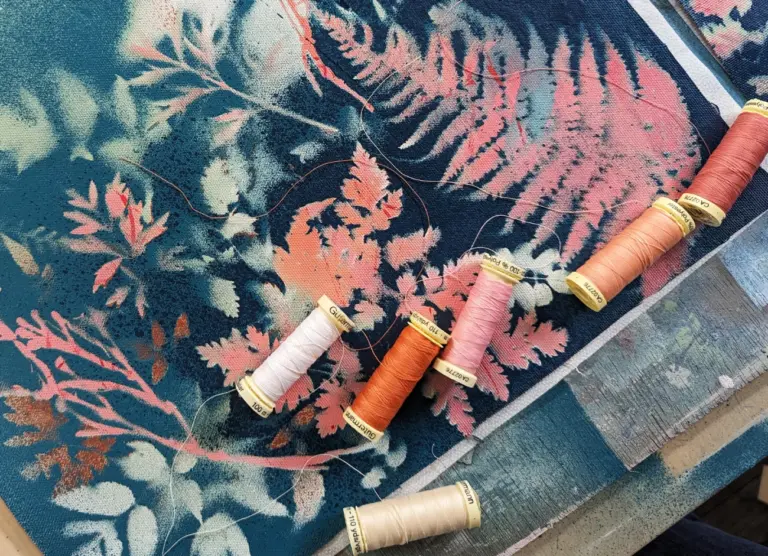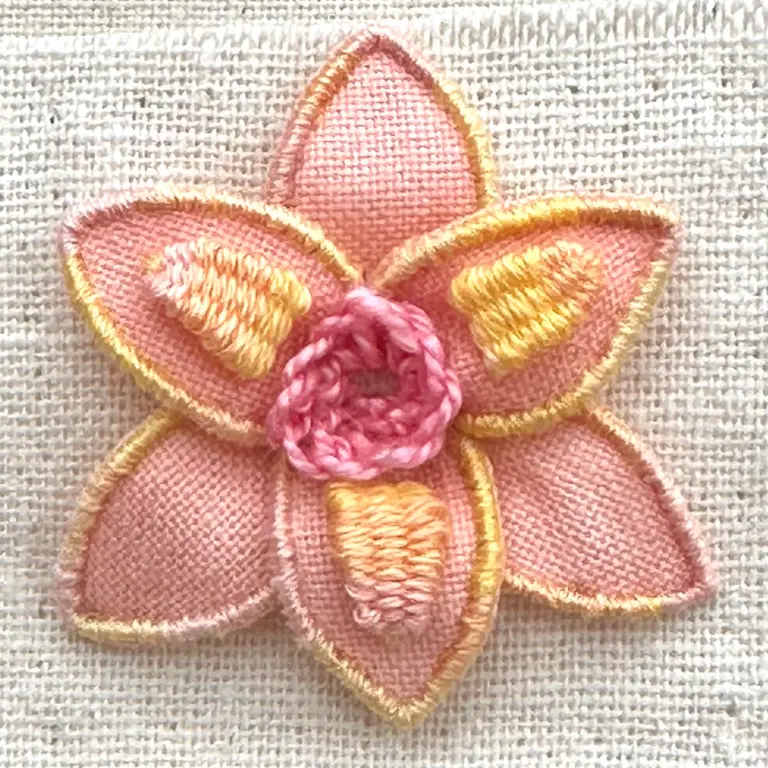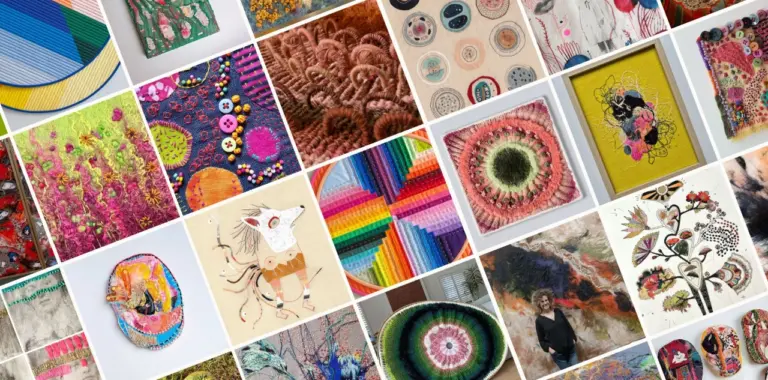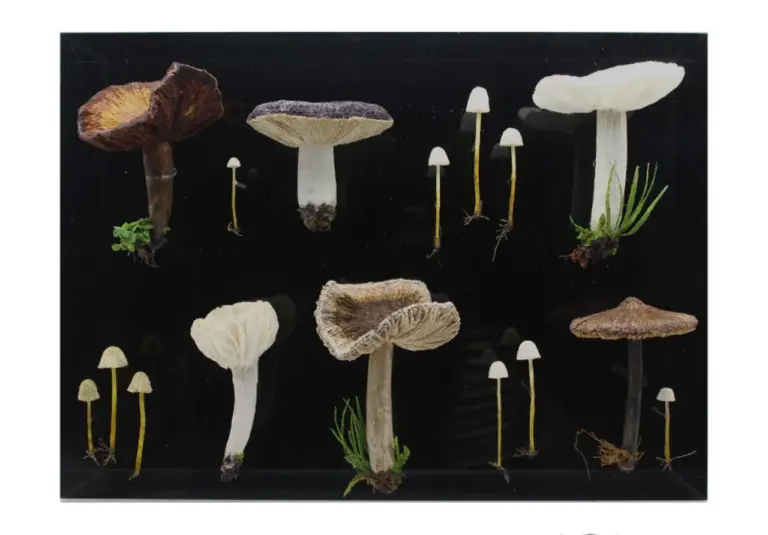In episode 7 of our Textile Talk podcast – where we interview with inspiring artists – we talk to Mixed Media embroidery artist and author, Christen Brown.
Textile Talk with Christen Brown
Listen to the podcast now or read through the transcript below.
Gail: Hello, everyone, and thank you so much for joining me on this Textile Talk podcast. My name is Gail Cowley, and I’ll be your host for this episode. Today I’ll be speaking to Christen Brown, who’s chatting to me all the way from California, US. And is an accomplished author in the embroidery field.
To give you some background for Christen, she began writing books for C and T Publishing in 2011, has authored seven books, designed three sets of embroidery stencils, as well as other embroidery products. Christen has also written articles for Michael’s Arts and Crafts magazine, Threads Magazine and Piecework Magazine.
She first became interested in fiber arts after making clothing for her dolls as a child. Then from graduating high school, she continued her education at the Fashion Institute of Design and Merchandising in Los Angeles, California, where she graduated with an associate in Arts in Fashion Design. Christen began her career in the wearable art field in 1986.
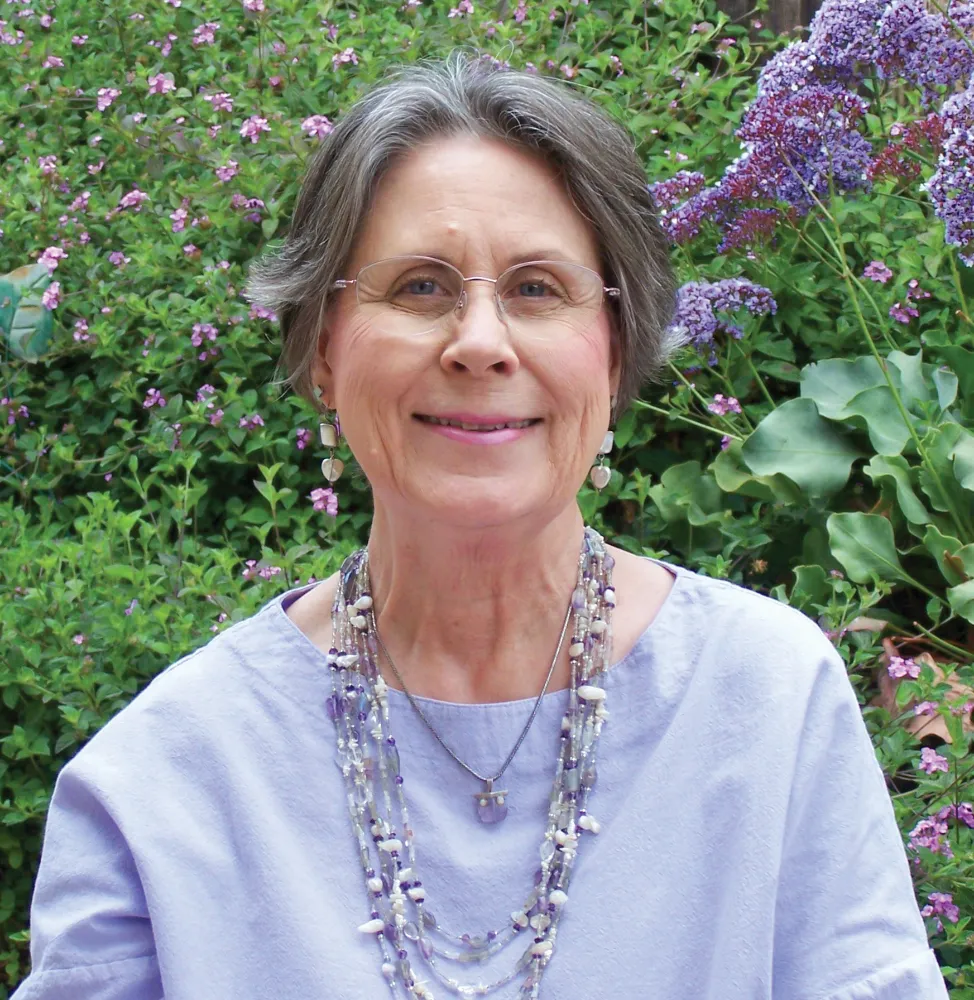
Her work has been shown in galleries and fashion shows all around the world. In addition, she’s been invited to participate in both the Fairfield and Manina fashion shows. Christen began teaching and presenting her work in 1991 for quilt stores and quilted fiber art gills on the West Coast.
She’s been invited to teach nationally for Road to California, America Quilters Society, and Quilt Festival in Houston. Christen still continues to be interested in craft and fine art. She experiments and learns all that she can, specifically concentrating on design and the techniques of embroidery, quilting, ribbon work, mixed media, and bead work.
Her goal and wish throughout this journey is to continually be surprised, inspired, creative, unnecessary. Thank you so much for agreeing to come on to the podcast. I know that you’ve had to get up quite early to do this, so my apologies for that. But thank you so much for joining us. It’s an absolute pleasure to have you here.
Christen: Well, thank you, and I’m thrilled to be here, and I wanted to make sure everything was going to be perfect.
Gail: Oh, bless.
Christen: Yes.
Gail: I think we’re both quite relieved it’s a podcast, aren’t we, and not a video link.
Christen: Yes, there would have been a bit of spackle probably involved in getting my face to look right.
Gail: So I think the first thing that I’d like to sort of ask is if you could tell us a little bit about the piece that you’re currently working on, what your inspiration was for it and what it’s made from. So the processes, really, that you enjoy using.
Christen: Well, the piece that I was working on was a sample from my newest book, Creative Embroidery mixing the Old with the New. It was actually designed after one of the projects that are in the book. And what I had compiled were some little bits of scalloped edge hanky. And I had four tea napkins that were given to me. So I collage pieced those onto a muslin base, and those then were hand stitched down because with the edges so you had a finished hand stitched edge as well as the machine stitched scallop edge.
Those were really delicate pieces, so I don’t use a machine when I’m doing any kind of collaging like that, and I don’t want the machine stitches to show, so they’re very tiny stitches that I use. And once I had my base put together, then I added in some vintage jacard ribbon that I had collected and some newer cotton laces. So I created areas for the stitching to rest and also areas for the stitching to shine.
Some of the tea napkins had some hand embroidered sections in them, and they were white, and I was using pinks and greens and cream, so I wanted to make sure those showed. So I did a little stitching around that. And I used tatting cotton, which is not a usual stitching medium, but I had some leftover from when my mom was a tatter and so they are finer than a pearl cotton number twelve, and they just look nice when you’re working with the floss and the pearl cotton. And it also has silk ribbon embroidery on it too.
So little sections of all of those. So when I went to put it all together, I decided that I didn’t want a traditional backing, so I used another tea napkin that was large enough to fit the piece on, and then I was able to use that as my backing for it, and it hung down a little bit below it with some more embroidery. So it’s an unusual piece, and I had it hanging from an old shoe stay.
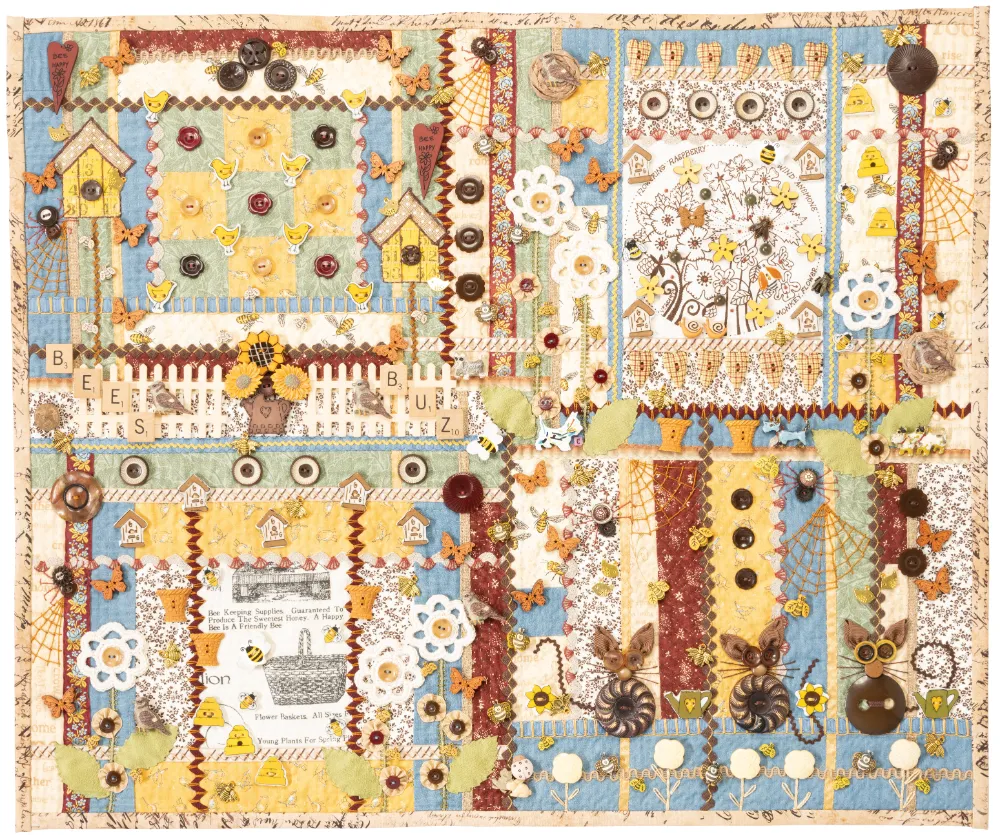
Gail: Oh, how interesting.
Christen: So that was kind of fun, I’m sure.
Gail: How much of it do you plan beforehand? I mean, do you do a design that you work to, or is it very much intuitive with the materials as you’re going along?
Christen: When I’m doing something like this, I let the piece talk to me, I look at it and I see where I can add things. So I don’t necessarily plan any of the stitching, I just let that go and flow as I go. When I’m doing a piece that I consider an all over piece, where the design is all embroidery, I do start with some idea of where I want to go and what I want to include, but something like this, I just let it happen.
Gail: Yeah, and I suppose it’s obviously a mixture of vintage materials mixed with newer materials and newer techniques. Is that quite important to you?
Christen: Well, this particular book, it was creative embroidery, mixing the old with the new, and there was a chapter dedicated to what you might find in your stash. So your stash could be new or it could have some older pieces to it. So when I’m working and it’s related to that concept, yes, I do like to work with older pieces and rescue them and give them new life. Somebody made these, and you find them at the thrift store, and you wonder why somebody would have discarded them. They were so beautiful. Right. So I try to give life to something that might just have been forgotten.
Gail: Yes. I suppose something we perhaps don’t always think about. But all of these pieces, all of the older embroidery pieces that we see in thrift stores or in vintage stores, all had their own life, didn’t they? Before they came into our lives, they all had their own stories, right?
Christen: They did. And you hope that someone will appreciate that they got a new life, that they were rescued.
Gail: Yeah, absolutely. Even though they’re not perhaps in their original form, it’s still lovely that they’re able to create something new. I suppose that brings me round to asking, thinking of origins of stitching, how did you first begin to embroider? Did someone teach you? Was it something that you were just naturally drawn to? How did that come about?
Christen: Well, my mother was self taught in all of the needle arts. She embroidered, she crocheted, she knitted, and she did needlepoint. And so she was always working on something. And I remember for my birthday one year, I think I was seven, and apparently that’s a pretty normal range that people learn how to work with their hands.
I was given a box, my little sewing kit, and it had a hoop in it and some embroidery floss and some I think white fabric is probably what she chose. And I just started stitching. So my mom taught me all of the basic stitches, and I just continued to stitch. I have dabbled in other needle arts, but I love embroidery, and not a day goes by that I don’t take a stitch. And something that I found when I started experimenting with other types of embroidery, I learned how to do silk ribbon embroidery, which uses some of the basic embroidery stitches. But you’re working with a material that’s quite different than thread.
The silk ribbon is different to work with. And I was able to introduce my mom into silk ribbon embroidery, and she made all of her own greeting cards, and she would either embroider or paint the cards. And so she started doing silk ribbon embroidery for the greeting cards that year. And that was nice.
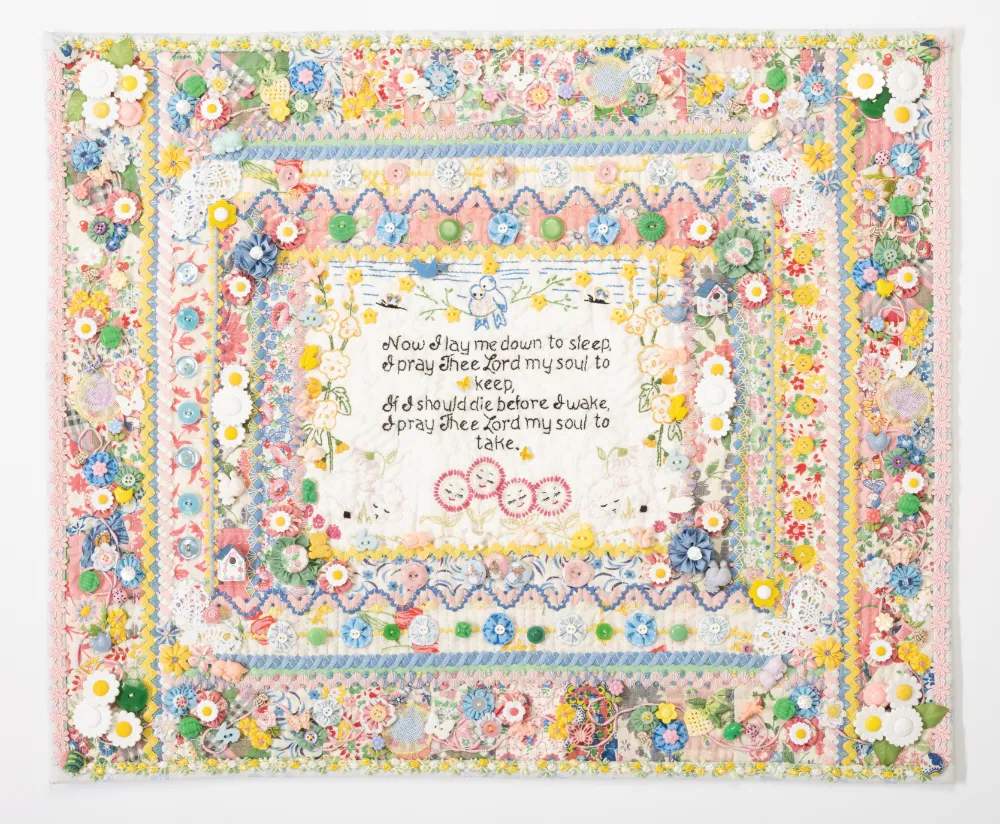
Gail: That was lovely to be able to introduce her to something after she’d introduced you to embroidery. It’s really nice. That was the silk ribbon embroidery is a really interesting art form. How did you come to choose that particular material? Was it something about it that drew you?
Christen: I believe it was I think it was one of Judith Montana’s earliest books. And she had shown some silk ribbon embroidery stitches, and I believe one of them was the Woven Rose. And I found it so easy to do, and it was so beautiful. I thought, wow, okay. So this got me interested in working with it, and experimenting with the stitches, and I really have enjoyed working with it. And at that time, it was a lot easier to find in stores. Now you have to go online, basically, to be able to find it. But that’s okay. We can do that. We know how to do that.
Gail: Yes. I think we’ve all learned, haven’t we, over the last couple of years with the pandemic, where to get things online.
Christen: Yes.
Gail: One of the things that I’ve always loved myself about silk ribbon is that it grows quite quickly, doesn’t it?
Christen: Yes. You’re able to see your design and so much faster than when you’re working with one strand of floss. Right. Because even the two millimeter silk ribbon is a lot more dimensional than just working with cotton thread.
Gail: Absolutely. It does have a very because of the silk and the sheen, the colours are very attractive colours. They’re very kind, very vintage, really, aren’t they?
Christen: They’re soft. And you also have a little bit of you feel like you’re working with something that has some history to it. I know that pearl, cotton and floss have history, but this has a little different bit of history, and it’s so feminine, and it just makes you feel special, I think, working with it.
Gail: Absolutely. So what made you decide to work with textiles as opposed to just I don’t mean just, but treat them as a hobby? Where did that sort of change come in?
Christen: Well, I started working with textiles because my mom sewed all our own clothes, so we had extra bits of fabric. And her best friend, which who we called Aunt Mert, she went to nursing school with her. She had all of her clothes made by a tailor, so she would give us all of the leftover bits. So that was really how I started, was with the leftover bits. And we would just do little tiny projects with that. And I think also, like many people my age, I had home EC in 7th and 8th grade, and in 7th, it was this big stuffed animal.
So you learned how to sew, you learned how to stuff, and you learned how to do hand stitching with it. So I think that was the idea behind the gonk. And so we got to go into that cupboard where my mom had the leftover bits of fabric and choose what we wanted to make our gonk with.
But in 8th grade, we actually started making clothing. And at the end of the year, we had a fashion show where we wore the clothes that we made. So I, of course, being an overachiever, had to make two garments, and one was a short little pair of shorts and a blouse, and then the other was a long, aline dress. And I got to end the show with the dress. So I think the camp in me and all of that led me to working with going into wearables because I got an applause at the end of the show. Yeah, absolutely.
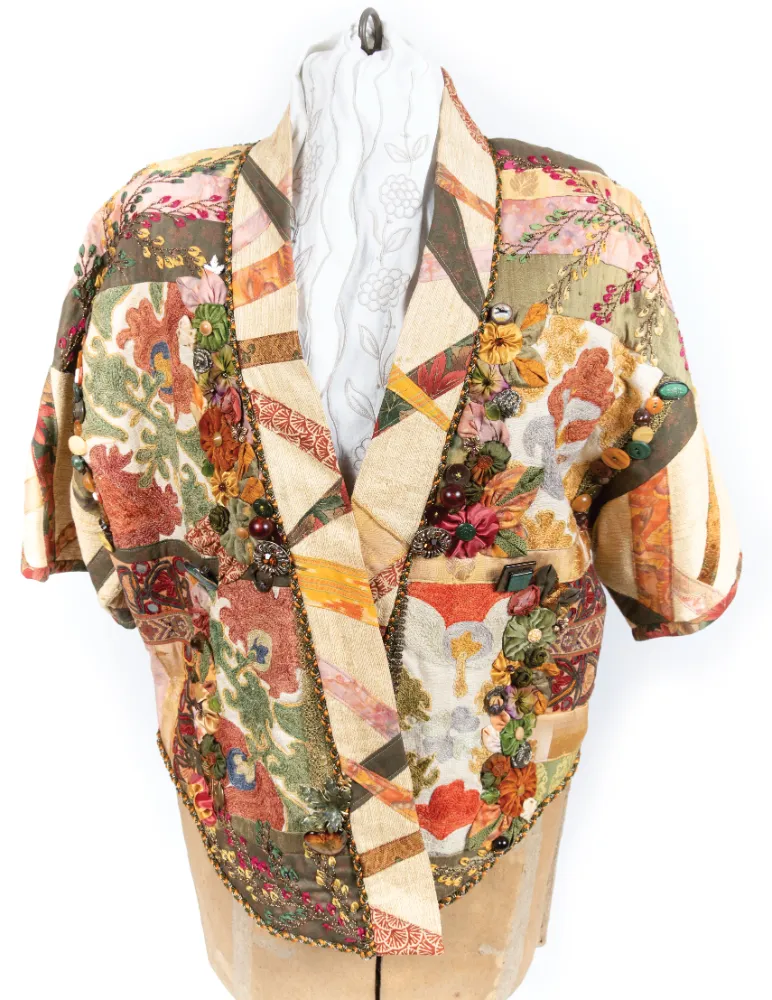
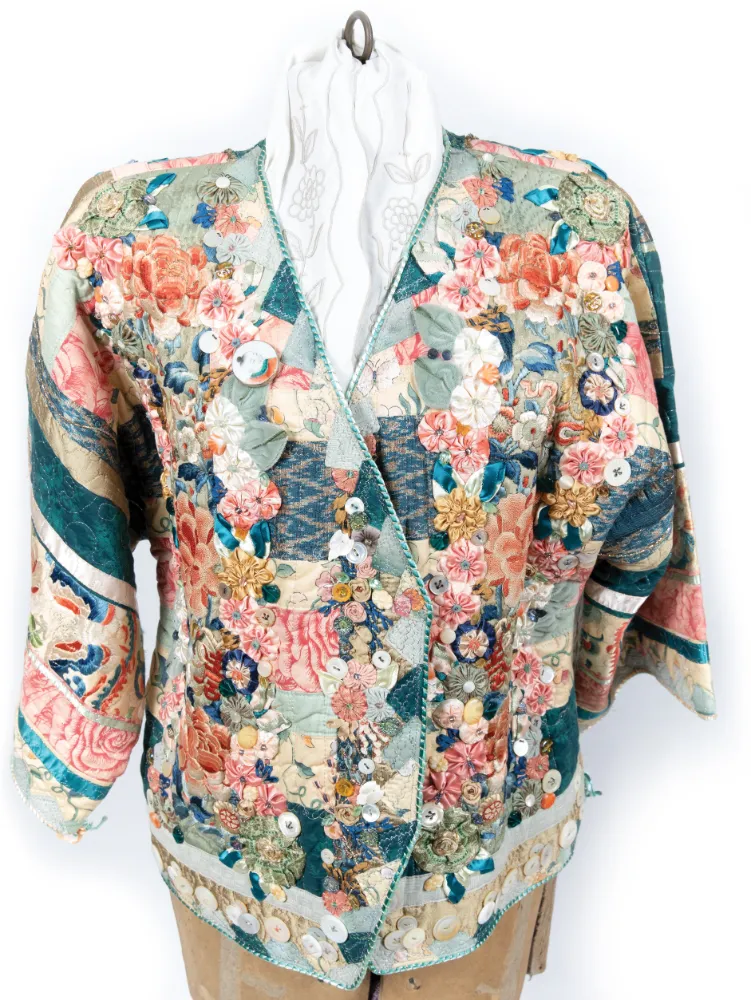
Gail: It always helps, doesn’t it? Yeah. So, obviously, you then became interested in wearable art. How did your career evolve from there?
Christen: Well, my first job was working in a fabric store, and we had to make all of our clothes out of their fabrics. So what that did was it also sold their fabrics, but it got you so that you were able to help a customer come in with their pattern and say, I don’t understand these directions or that type of thing. So we got really familiar with directions and then with the fabrics and really what people were interested in.
And there was a woman working with me at the store who was going to the Fashion Institute of Design and Merchandising that was in La. And I didn’t know what that was. So I got interested in it, and I got a Cal Grant to be able to go there for two years. I have an Aam fashion design, and it all kind of went from there, though. I decided that the fashion industry was a little bit more aggressive, I think, than I was really ready for. I had to start as a pattern maker, and I really wasn’t that great at pattern making. And in addition to being the pattern maker, you had to be a model. And I was very thin, but I did not have the proportions to be a model for that. So I kind of put the fashion design on hold. But I still continued to make all my own clothes, and I enjoyed that. I enjoy it still.
Gail: From everything that I have heard about it, it’s a very cutthroat world.
Christen: Yes.
Gail: That was said with stealing.
Christen: And even in school, I found when I was going to school, quite a few of the people were either sons or daughters of actors or knew other designers, and they were the ones that got the jobs and that type of so you had to know somebody, and I didn’t. That’s okay.
Gail: It’s demoralizing, though, isn’t it? If you’re not being judged on your talent, but you’re being judged on who you know.
Christen: Yeah, but that also growing up in La. That’s the whole movie industry as well. And I understand that. And that was okay. I thought, okay, well, maybe this means I need to go somewhere else and just work on something else. And so I did.
Gail: It obviously must have given you a big appreciation for fabric and the properties of fabric, though.
Christen: Oh, yes. I can’t walk past a fabric store or anything without going in and fondling. We have a beautiful store in San Francisco called Brightex, and it is three stories wonder. And I got to go in, and I was with my husband and daughter, and Gwen was very young. She was ten, I think, at the time. And I just was so pleased that the gentleman greeted us when we walked through the doors. And he said, oh, FAO Schwartz toy store is just down the street. He told my husband how to get there, and I had hours to be able just to look through the three stories of wonder. So fabric on the first floor, buttons on the second floor, which I had a hard time leaving that particular floor, and then notions on the third. So, yes, I love fabric.
Gail: Strangely enough, I have actually been to that store.
Christen: Oh, you have?
Gail: It’s just off Union Square, isn’t it?
Christen: Yes.
Gail: I remember being absolutely amazed just by the variety and everything that they held. I mean, there was nothing that you could want that wasn’t there. Unfortunately, we were on a long trip and we had pretty much full bags by then, so I had nowhere to actually stash fabric to take it home, which was possibly a good idea. Really.
Christen: Disappointing. I guess.
Gail: Someone did say to me, actually, when I got home, why didn’t you buy it and post it to yourself? And I thought, why didn’t I shoot? Yes. Why didn’t I think of that?
Christen: Well, shame on that man. That didn’t or whoever was working with you. Too bad they didn’t suggest it, right?
Gail: Very true. Yes. But no, you’re right. It was a wonderful store. Amazing experience to go around here in the UK. We don’t really have stores of that kind of size. I think possibly space is usually at a premium. Retail stores pay a lot for their space. So to see something like that is really special.
Christen: Yeah, it was. And that, I think, is probably the I have not been to New York, and I’m sure there are places in New York that probably you and I both would love to go and maybe have the same problem tax suitcase so we don’t have to buy more.
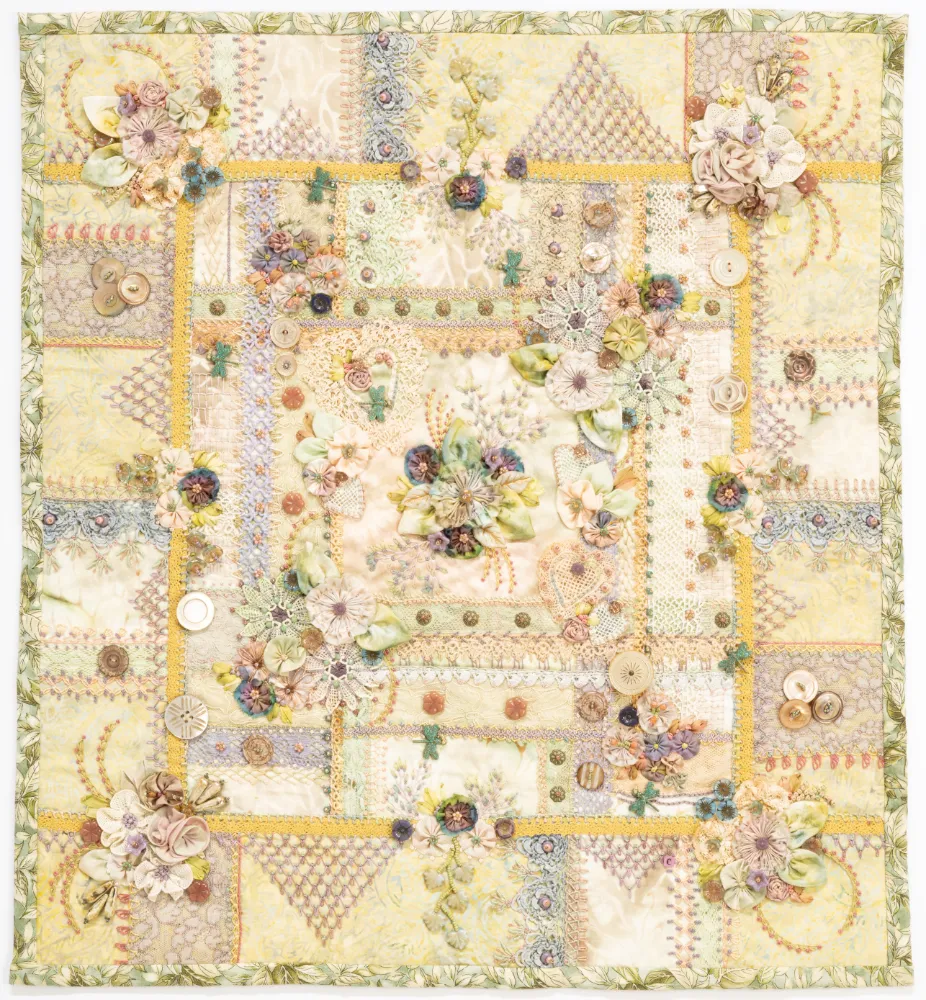
Gail: But at least we know what to do now. We post it to ourselves. I know that obviously you made that transition from wearable art into fiber art. Could you tell us a little bit how that came about?
Christen: Sure. I first started making wearables in, I want to say, 1986. That’s when I was asked to participate in the Fairfield fashion show. And then Fairfield turned over their fashion show to BERNINA. And I had started teaching wearables in, I think, 1991, it was. And then around 2000, the whole industry changed a bit, so it stopped really focusing on wearables and then going back into quilting and then fiber art into smaller pieces. So I adapted quite a few of my wearable art classes into smaller pieces. So small wall hangings even into some soft sculpture. So I started also into doll making at that time. And that’s really where it transitioned into.
Gail: The doll making is a very specialist area, isn’t it?
Christen: Yes. We had a group here in San Diego that had some national artists in it. So our doll group had some wonderful teachers. So I learned how to paint faces, and mine are very much character. They’re not realistic faces, but very much character.
And as a kid, I remember clothing all of my dolls before I gave them a name because I wanted to make sure they had something to wear. Right. So that’s what I enjoyed was creating patterns that looked like clothing. So that was really what the pattern was and then being able to paint the face. And I always made their hair different colours of yarn because I always wanted to have purple hair. I mean, who wouldn’t, right? So my dolls got to have fun hair.
Gail: Wonderful. I know that you have obviously gone on to author quite a number of books, and you clearly enjoy passing on your knowledge to others. Can you tell us a little bit about the process of writing the books? I know that many of our students, when I speak to them, it’s something that always fascinates them. How do you get a book deal? How do you actually put a book together? So could you tell us a little bit about that? Because I know they would love to hear.
Christen: Sure. So first of all, I never thought I had anything to share. I didn’t realize that I had this knowledge in me. And when I had my first job teaching, somebody asked me to teach, and I was thinking, really? Okay. And I always say okay before I really think the process. So I said, okay. And so we decided to have one class. She filled that in a week. And so we got another class going. And the first class I taught, it was all verbal because I thought that the students could follow. It was a three hour class, and everybody left dazed.
Gail: Yes.
Christen: So I thought, let’s not do that again. So I wrote out a handout. And that’s basically how you would start a book, so you would outline what you want to talk about. You would make sure the one thing that I find a bit of a challenge my books are all 160 pages. Not 161, not 162. So you have to get all of that information and all of the gallery pieces and all of the how to’s into that amount of space.
So that’s another thing you want to think about, how many pages you want your book to be and that type of thing. So the first book that I proposed to CNT Publishing was RibbonWork Gardens. And I had an outline. I knew what I wanted to include in the book, and I took all of the how to photography. I did that for my first three books. So offering something to them that maybe they didn’t think about is another good thing to be able to do.
Gail: Did you have to actually supply them with an outline or a sample from the book beforehand?
Christen: I believe what I did was I filled out a questionnaire. I think most publishers would have a questionnaire when you’re going to propose something to them. So I filled that out. I did have an outline, and I didn’t send in physical samples, but I sent in JPEGs of the work. And you may have an outline and you may have an idea of what you want to include. They are always going to have an opinion as well.
Gail: And how do I put this? Is it an intrusive opinion?
Christen: Well, sometimes. And you have to be able to say, okay, so the first book I wanted to call A Walk Through My Flower Garden because that was the name of a garment class that I had, and it included a lot of the instructions that were going to be in the book. But they felt that title sounded more like a gardener would be interested in. It would be a gardening book rather than a book on ribbon work.
So I believe that they had the right instincts to go that way. At this point, after I think it’s seven books, if I have an opinion that I think is a little stronger, I can at least give some more comment on it and we can come to an agreement for something. But both of us now have an idea of who the audience is and what they may be looking for. And that’s really what we’re trying to do, is provide something for those who are here and those who are coming after us. We want to provide that information to them.
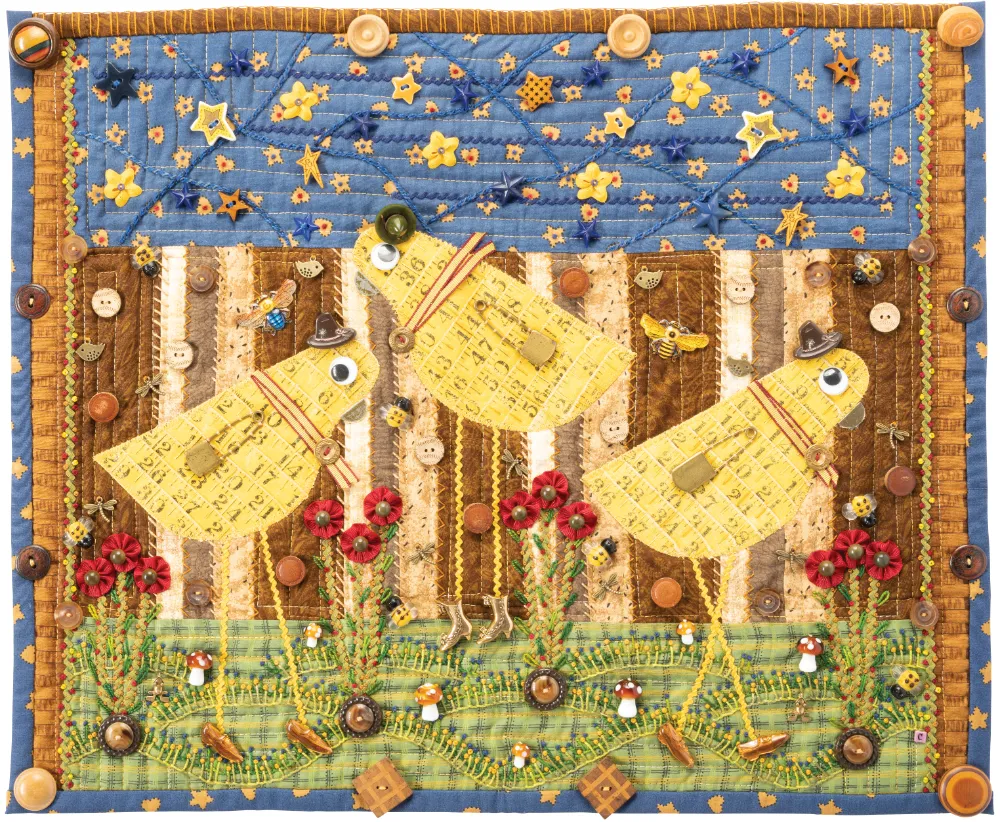
Gail: And how do you actually go about putting the book together? Is it something that you have to actually lay out or do they do that? You supply the text and the images and they do the layout. How does that work?
Christen: There is something that’s called a Bookmap, and it’s an Excel program where they’ll list each of the pages. It won’t be with the text on it, but you can see how long a chapter is going to be and if it’s going to fit within the whole idea of how many pages you have. But I also know how many words per page need to be in each page, because you have to decide how big a picture is going to be or how many pictures there are going to be and how much text you can actually add in. So that part is a little challenging, but it’s something I become an expert at.
Gail: Yes, I can imagine seven books on it certainly sounds like a challenge. I mean, to keep that amount of information in your mind. Or I know obviously, that some software will help, but it’s a lot, isn’t it? It’s a lot to work out.
Christen: It is. And one nice thing, once I had an idea how many stitches could fit to a page, because that’s really a big portion of my books are to include the embroidery stitches and the illustrations. So once we had that down, we could really work on the other pieces. And really, you can pare down your wording. You can pair that down, so it’s more streamlined. But one thing that I try to do when I’m writing is I try to write as if the reader is in class with me, because I think that’s an important aspect. I want them to feel comfortable, and I want them to understand what I’m trying to pass on, and that’s important to me.
Gail: Yes. Sometimes I think we’ve all read instructions, not necessarily books that you’re as confused by the time you get to the end of them as you were at the start.
Christen: And I do try to include tips and tricks, that type of thing. So I hope that people read that sort of information, too, before digging into the stitches. But I try to outline everything they’re going to need to know. So always there’s materials, always how to use those materials, and thread length needles, that type of thing.
Gail: Yes. Right. From the basics, so to speak, everything that someone might need to ask.
Christen: Yes.
Gail: When you were obviously talking about having gallery spaces within them, is that always your work, or is it sometimes students work as well.
Christen: I believe. My second book, I had a friend who actually was a student before we became friends, and she had a piece in there because she helped me do some of the editing. So that was nice. And then in the last book that I just wrote, I have a friend that’s also written a book, and she teaches she and her friend have gallery pieces in the book.
Normally it’s just my work, but it was nice to include theirs because they helped me with some of the ideas that we used in the what’s in Your Stash chapter. And that’s where we talk about the or I talk about the vintage items you might find. So I had a lot of their input, and I felt that it was special to put their pieces in.
Gail: Yeah. And I’m sure that obviously, that was lovely for them to be able to see their pieces in print.
Christen: I hope so.
Gail: I’m sure it was. When you start to plan, do you have an idea of the number of, I’m going to say, projects that you’ll include?
Christen: Yes, that’s part of the outline, and it’s also part of, I guess, the mission of the book, what you want to teach them, what you want to be able to show them, what they can do with their things. And I think another important thing is to be able to offer projects for all levels.
My work has a tendency to be at a level where the student needs to be either at least intermediate and sometimes advanced. And I don’t want to discourage anybody, so I want to be able to provide some beginning projects as well as some intermediate and advanced. And another thing that I try to also explain, when I first started teaching, I had those labels on my classes. This is a beginning, intermediate, or advanced. And often in the intermediate and advanced class, I get a beginner who felt that she was a beginner crocheter. So of course she would be a beginner embroiderer.
Gail: Yes.
Christen: And that was not the case. So it’s being able to explain what you need to have before you’re able to work on this project. Otherwise, people get disappointed and they think, well, this isn’t a good book, or, this isn’t a good teacher. I wasn’t able to make that piece. So you don’t want them to be disappointed. That’s the main thing.
Gail: We do have that problem with our students, try to help them decide whether they’re maybe coming in at a beginner’s level, a skill stage two, a skill stage four. And people can have very different views about if they want to push themselves with a course.
Some people will always want to go out of their comfort zone and push for the next level. Some will always want to stay within it and feel that they don’t want to push themselves too hard. So it is difficult trying to help people understand what level they’re already at.
Christen: Yes. And I think in your situation, you have a little bit more time to talk to them. But when you’re in a three hour or a six hour class and you have other students, it can be a little bit of a challenge. And I think both you and I would, and all of your teachers would want that person to do their best and have the best time so that it can be a challenge, and it’s a challenge for the person as well not to realize that. Oh, oops.
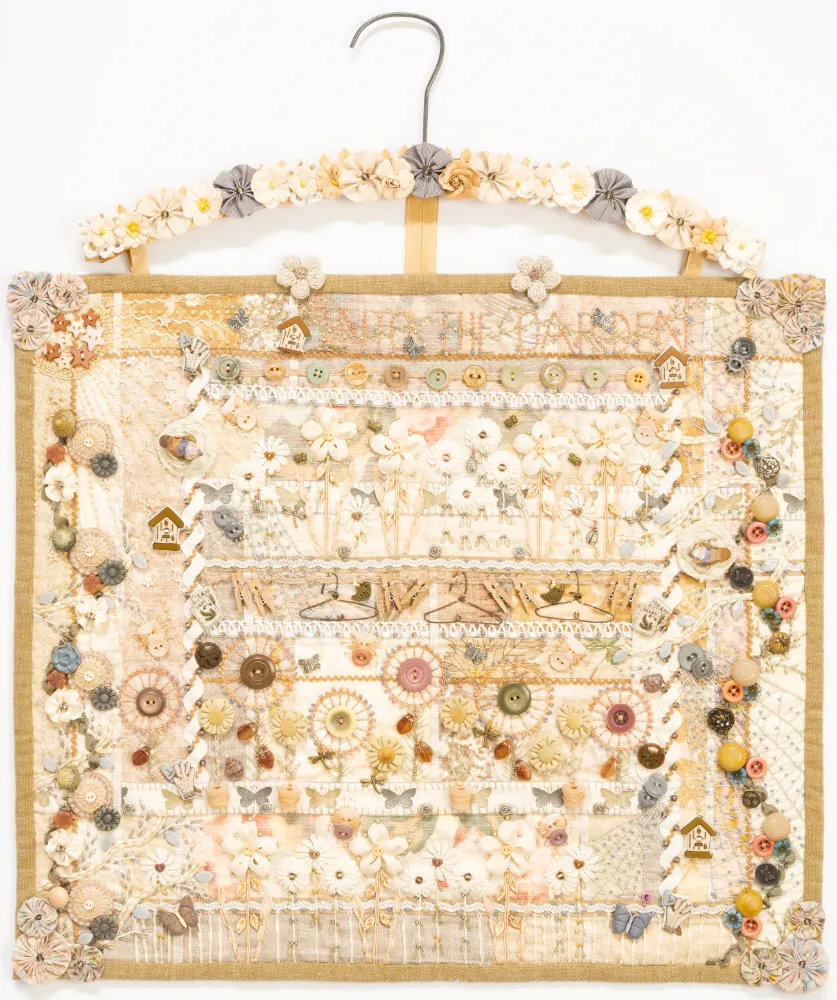
Gail: Yes. Absolutely. I suppose that looking at some of the embroidery books that are out there over a long period of time, some decide that they’re going to just do beginners projects, others decide that they’re just going to cover advanced techniques. I like the way that you’ve described mixing them, because it gives people that ability to step up or step down, doesn’t it?
Christen: Yes. Like I said, everybody’s happy.
Gail: Yes, hopefully. So we touched briefly before on the pandemic, which is obviously over the last, what, nearly three years, is it now?
Christen: Yes.
Gail: Has really affected all of our lives in lots of different ways. Were you very productive during that time? Did you do different things? How did you use that time that I think most of us had because we were having to stay at home a lot more?
Christen: Well, for me, I believe the pandemic started when I was just working on the projects for this book. So throughout the whole pandemic, either I was creating, writing, or editing, and we didn’t talk about that particular part when we were talking about writing a book.
The editing process could take a whole entire year, so just depending on how long your book is. So I was fortunate that I needed. To be home anyway, so I was able to work on that. But I think it was scary for everyone. I don’t want to say I benefited from it because that’s not really a positive thing, but I was able to work at home.
Gail: And that was, I think, many creative people actually did. I know it sounds an odd thing to say, benefit, but I think by having less distractions, obviously, and having to spend more time at home, I think many people found that they were very productive during that time. Everyone will have a different experience, of course. You’re absolutely right. We didn’t touch on the editing process, and and actually, I did wonder, do you edit your own books or does somebody from the publisher then step in and edit them? How does that work?
Christen: I have to edit it at certain stages of the process. So there’s a first draft, and then there’s a final draft, and those are mine, and I edit there. And then they start editing. And editing could be anywhere from, oh, let’s just switch these words around, or let’s get the directions to be a little bit more understandable. When I get an editor that’s either adding words and I’m like, no, you can’t add any more words to that page because we could only have that many words there. But it always seems to work out in order to pass it on to them. I do the editing. But again, there’s many stages of editing and many other editors that get involved in the book.
Gail: So just as a rough idea, how long does it take you from sort of originating an idea for a book to the book actually being available for purchase?
Christen: It’s probably about three years.
Gail: Oh, wow. That is a long time.
Christen: It depends on when you turn in your proposal. That could take anywhere from three to six weeks to get an answer back, right? So there’s that process. Then you’re going to talk to an editor that is an acquisitions editor, if you, in fact, do get approved. And then you details from the outline that you’ve turned in. And then you decide when you want the so we work backwards when you want the book to be published, then you work back to see when the dates are that you need to turn things in. So because my pieces are so involved, that’s why it probably takes me a little bit longer because I need at least a year to create the pieces that go into the book.
The writing is not as time consuming as it was in the beginning because my first three books, I was doing a lot of directions, and now that I’ve got all of those directions down, then I can just add to them and use those already used directions. I know that they’re going to work.
Gail: We obviously now get a lot of books via a digital download, via Kindle or something. Is that a feasible thing to do with an embroidery book.
Christen: My all available as ebooks. Is that what you’re it is, yes. Okay. I think though, when my students bring an ebook to class, so my book as an ebook, rather as a paperback, what can happen? Depending on how big the device is, you might not be able to see all of the instructions in page.
Gail: Yeah.
Christen: And the other thing that I found were the page numbers weren’t always the same.
Gail: Yeah. It will differ with the size of text and everything.
Christen: Right. So that was a problem in the beginning. When you download a book on your computer and you’re working with the acrobat right program, all of the page numbers should match just as they would in a hardback or a paperback. But I can’t say for certain that they would on a smaller device.
Gail: And I suppose because so much of the books will be images, that’s going to make them quite large, isn’t it, from a file size point of view.
Christen: Right. And I don’t think you can see all of the details quite as well on a smaller device. But I think if you understand that and you’re willing to say, okay, but at least I can have this book because it’s a lot less expensive to go in the ebook form.
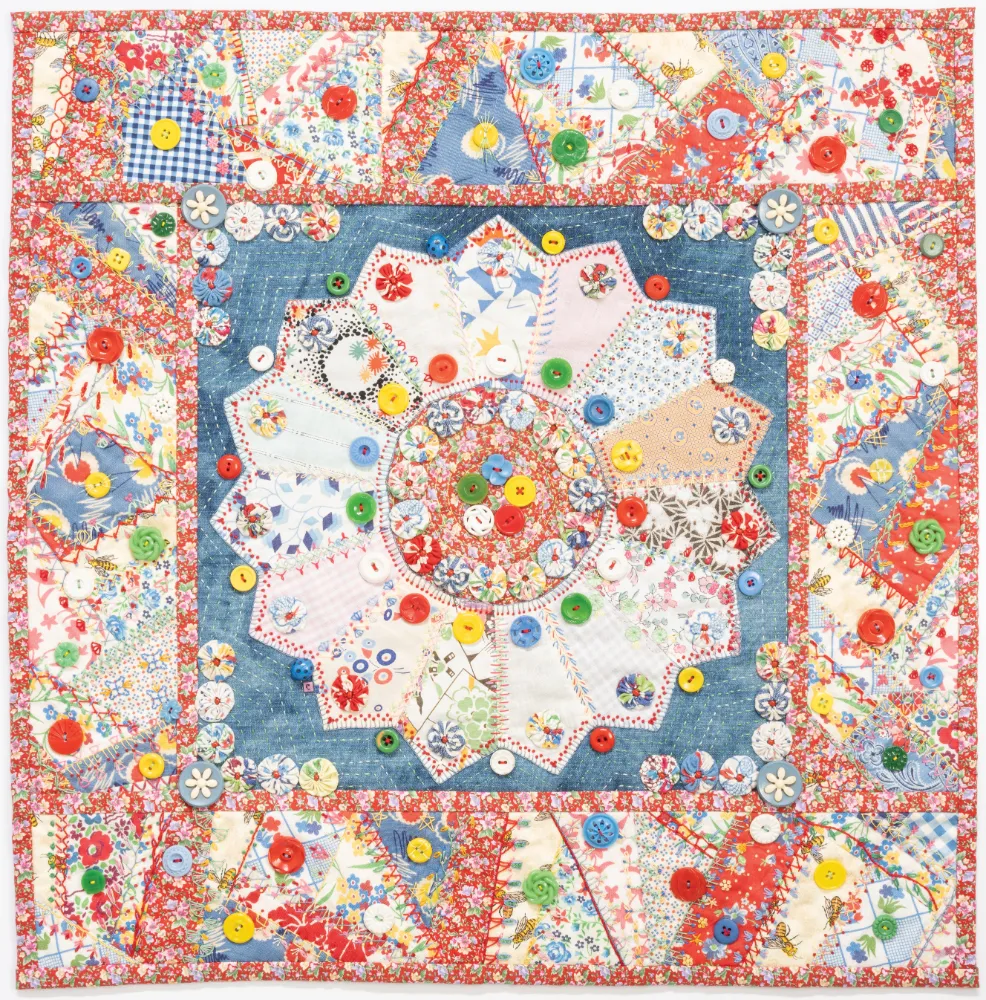
Gail: And it’s immediate as well, isn’t it?
Christen: Yes.
Gail: If you just can’t wait for the mail to come.
Christen: And I think that satisfies another thing, you get it right away.
Gail: Yeah, absolutely. So what’s next, Christen? What have you got planned for the next thing? Have you got exhibitions or a new book that you could tell us a little about?
Christen: Well, I have a new book that I can’t tell you anything about.
Gail: Okay.
Christen: Yes. But in the future, I have a book that is all on hand embroidery using pearl cotton and cotton floss. And that’s the hand embroidery dictionary. And there are 500 plus stitches. There are actually over 700 stitches with the variations. And then I have a book on beaded embroidery. But I would like to have a book that focuses on raised and textured stitches. I’ve used some of those stitches in my projects, and the one book, the embroidery book includes them, but I’d like to get more involved in. You can add a tatted stitch that you’re actually using a needle and thread and stitching it onto the fabric. And I’d like to include more cast on and bouillon stitches. So that’s a future thought.
But right now, I think we were talking earlier about not being tech savvy and I’ve had to be kick started to this century quite quickly. I have a video lecture and class on CNG Publishing’s online learning platform called Upcycle. It with Embellishments, and it’s basically taking thrift store finds and creating them into something new and something that you would wear. So with that in mind, I am going to be videoing some classes on embroidery. And we’re going to start with beaded embroidery. So in the next couple of months, hopefully there will be some classes in that. That’s good too, because now I’m learning, so I appreciate that.
Gail: And how are you finding being on the sort of end of the wrong end of the video camera, should I say?
Christen: Actually, I prefer well, because most of these are going to be close ups on my hands. I’m okay with though. I’m thinking, oh, those hands do look 67 years old, but I’m hoping that that’s just a byproduct of the class. But when I’m actually being videoed myself, I think, oh, I just can’t wait till it’s over.
Gail: Yes, I’m not too keen. I must have met we have at various times done quite a number of videos and we often have just a full day at it where we do nothing but record. And they’re really long, hard days.
Christen: Yes.
Gail: I don’t know if you found them that way, but I found them really they take a lot out of you and everyone else that’s involved as well.
Christen: Yes. I had to drive up to Concord to shoot some of the video for that lecture and I had had surgery on my foot and I was just at the point where I could walk on it and we had a 15 hours day shooting the videos and I thought, okay, this could be over. Where’s that glass of wine?
Gail: Yes, absolutely. Yes, I know that feeling really well. That’s actually one of the reasons I love doing the podcasts, because it’s much more immediate and I think because you’re not on video. I know we had that discussion before we before we spoke today. We’re going to have to be on video, but because we don’t actually do that, it’s a more relaxed it’s a more relaxed chat, whereas you’re always wondering which side you’re showing to the camera.
Christen: And I always worry that I’m not looking at the camera, I’m looking at the screen. So you’re not seeing yes, I agree.
Gail: It’s tough. It is tough as a teacher, obviously being the one that’s actually being recorded, looking into the camera, but also perhaps having another camera actually on your hands as you’re trying to demonstrate something. It’s really hard. It’s hard to concentrate and it’s hard to be looking in the right place, saying the right thing.
Christen: Yes.
Gail: I find maybe that’s just me. Other people seem to cope better, but me too. So there’s a top secret book coming out that we yes. Do you have any idea of when it will be available for purpose?
Christen: It will be available in 2025.
Gail: Okay, so we’ve got a little way to go yet.
Christen: Yes.
Gail: And as we’re obviously, I know, nearing the end of this chat that we’ve had, do you have sort of a short story or a little anecdote that you could perhaps finish off the interview with?
Christen: Yes. So my advice is to be true to yourself. After one of my lectures on wearables, I had a lady come up to me and she looked at the vest I was wearing and she said, the vest was so well constructed and beautiful, why did you junk it up with all that stuff? And I presumed she meant the embellishments, because that’s really something I like to do. And I went home and I removed all the junk and I looked at the vest and I thought, she was correct. It was beautiful without the junk, but it wasn’t me. So my advice is to do what makes you happy and put the junk back on.
Gail: Yes, well, I know with our students that particularly when they start studying with us, and I’m sure you’ve probably found this as well with your own students, that they can be very uncertain sometimes, and it only takes a chance remark by somebody to really knock their confidence.
Christen: Yes.
Gail: And at the end of the day, it depends what sort of person they are and how high their confidence was anyway, as to how easily they recover from that. Sometimes I speak to students who have an absolute horror of designing their own patterns or embroideries, and that’s come back from perhaps something that happened in art class when they were in primary school, some chance remark that the teacher made about them, you know, not being very good or and and it’s amazing how some of those remarks do stick. I think perhaps in life we could all do with just remembering that sometimes and trying, if we can’t say anything good, to perhaps not say anything at all.
Christen: I think there are some people that need a class on that.
Gail: Yes, I’m sure there are, particularly at the moment, because, well, now we have so much social media, don’t we? So everyone’s sharing everything, and it all goes really well until someone says something that’s perhaps intended to be helpful but actually comes over as a little negative. And that’s where things can sometimes it can be very upsetting if something that you thought you’d made a fabulous job of, unfortunately someone else doesn’t. But it has been absolutely lovely.
Thank you so much speaking to me today. I have so enjoyed actually hearing more about you and the process I do hope you don’t feel I went on about it too much, but the process of your books and the time that it takes has just been absolutely fascinating.
Christen: And no, I appreciate your questions about the book because it is kind of confusing to people, I think. How does this all work? But there is a lot of input from you as you pretty much as the author. It’s all on you, really. And you really have to provide everything to be able to do this. And I don’t mean just the photography, but I mean all the originations.
Gail: Yes. All the ideas and everything are coming from you, aren’t they? Do you find it hard, obviously, three years is a long time to maintain focus over one single project in that way. Do you ever get partway through and think, I don’t want to do this?
Christen: Oh, yes. Especially when it’s the editing time.
Gail: That’s the worst part, is it when.
Christen: You’re on a two week deadline and you’ve got to edit something and you start looking at it and you think, oh, my goodness, we’re in trouble. But there’s always a safe line, I guess you can say and say, it’s not working. I need a little bit more time. But I think the editing is the most stressful because you’ve got that deadline and get it done.
Other than that, once I finish all of the pieces that are for the project or for the book, I mean, and then I’m just working on the computer and working on the text, I’ll be starting the next book or the next thing. I won’t get bored because I’ve got something else going on.
Gail: So there’s an element of overlap between them as well.
Christen: Yes.
Gail: I think probably it’s a good idea for all of us, really, whatever we’re doing, to have something that when one project gets on top of you, you can just put it to one side, get on with something else for a little while and then return to it with fresh eyes.
Christen: Yes. Good. Well spoken.
Gail: Thank you so much for that.
Christen: Thank you, Gail. And I enjoyed speaking with you as well.
Discover More
Website: christenbrown.com
Blog: christenbrown.com/blog/
Facebook
Creative Spark, on-line Lecture/class: Upcycle It with Embellishments
List of Books and Products
– Ribbonwork Gardens
– Embroidered and Embellished
– Ribbonwork Flowers
– The Embroidery Book
– Beaded Embroidery Stitching
– Hand Embroidery Dictionary
– Creative Embroidery, Mixing the Old with the New
– Embroidery Stencils: The Essential Collection
– Embroidery Stencils: The Darling Motif Collection
– Embroidery Stencils: Crazy Quilt Seam Design Collection
– Embroidery Stitching, Handy Pocket Guide
– Embellished Art Embroidery Project Planner

